
Venereal Disease Treatment Menu: 1 2 3 4 5 6 7 8 9 10 11 12 13 14 Next>>
Venereal Diseases in the Golden Age of Piracy, Page 1
""This Distemper [syphilis] albeit it is not usually got aboard a ship; yet it often falls to the Sea-Surgeons Lot, to Cure it on board. Therefore I will shew the Cure of it in its different degrees.” (John Moyle, The Sea Chirurgeon, 1693, p. 138)
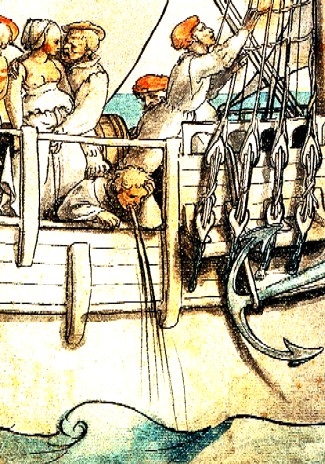
Artist: Hans Holbein the Younger
Bad Behaviors, Ship With Revelling Sailors (1532-3)
Given many sailors' reputation for illicit sexual unions while in port, it should come as no surprise that golden age of piracy era surgeons had to treat such problems. The treatment of venereal diseases were not part of a normal land-based surgeon's practice; there, the physicians held sway, diagnosing the problem in long-winded theoretical essays and prescribing treatments with medicines that were to be dispensed by apothecaries in an effort to 'cure' the problem. At sea, however, the surgeon was tasked with the roles of both physician and apothecary. Given the promiscuity of many sailors, it was a health problem frequently encountered; every sea surgeon's manual from the period mentions the treatment of VDs.
The procedures used to address these health problems were basically an extension of those employed in previous periods. Modern French historian Claude Quétel points out, "All those who have studied the history of syphilis consider that the seventeenth century and the first half of the eighteenth century brought nothing new [to treating the disease]."1 Shipboard 'cures' incorporated long-term medicinal treatment along with sweating and salivating, which sometimes required a bit of ingenious work by the sea surgeons treating their patients in cramped, close quarters.
This article begins with a presentation of concepts needed to understand venereal diseases in the sailor's world during the golden age of piracy (GAoP). It looks at how and where sailors and pirates might have acquired the illness, discussing the 'universal' theory of venereal diseases prevalent at the time, how sailors paid for their treatment and some of the suggestion forms of prevention. The article then examines the history of venereal diseases up to the golden age of piracy, focusing particularly on gonorrhea and syphilis. This is followed by a look at some of the more popular medicines sea-surgeons advised for use in treating venereal diseases. From there, the two main diseases - gonorrhoea and syphilis - are examined in detail, looking at their causes, symptoms and the variety of treatments employed by period sea surgeons and physicians.
1 Claude Quétel, History of Syphilis, 1990, p. 76
Understanding VD in the GAoP: Sailors Whoring in Port
There are a number of accounts of sailors contracting with whores and local women while in port in the period and near-period sea accounts. Several merchant sailors discuss the flesh trade in different locations. Several sailors who recorded their experiences during long careers mention women of pleasure.
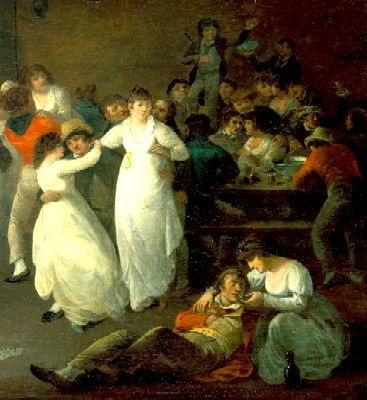
Artist: Julius Caesar Ibbitson
Sailors Carousing in a Tavern in Portsmouth (1802)
J.D. Davies mentions that in 1661, "the crew of the [navy ship] Montague used a period of leave at Lisbon to head en masse to 'Mount Whoredom', the hilly street that contained the seamen's brothels, and thirty-seven men (well over a tenth of the ship's company) were infected with VD."1
Sailor Francis Rogers noted that when he was in Dumas, India in 1702, that the "Parsis at Sually [modern Dumas], sell punch, toddy and liquors for the sailors... and [are] rare pimps."2 In June of 1704, Rogers was in Aveiras, Portugal, where he reported "the finest women that generally appear to common view are the courtesans, who will get by their doors well dressed, and barefaced invite men to them with a glib tongue, but are said to be generally dangerous and hot as their country is; as indeed several of our sailors experienced, but a clap [gonorrhea] is little regarded there"3. Not all the illicit unions Rogers described were with prostitutes. While at Gravesend in 1705, he shipped aboard the merchant vessel William Galley for Jamaica. As they were preparing the ship to sail, Rogers described a Danish passenger who "carried on an intrigue so far with a young woman of reputation that was smitten with him and his stories, that if we had not prevented it, (I) believe he would have married her, though he had a wife in Jamaica at that time."4
Merchant captain Nathaniel Uring discusses the oldest trade a couple times in his book about merchant sea travels. While stopped near 'Cape Appolonia' (probably near modern Atuabo, Ghana), Uring notes he and some other merchant ship officers were staying with a local trader where "a young Woman was sent to each of us, who came and whisper'd softly, and offer'd themselves to us"5. Uring begged off. He later says of the port city Tunis, Africa, "The City is very populous, as we may judge by the Number of Harlots, which I was assured were not less than
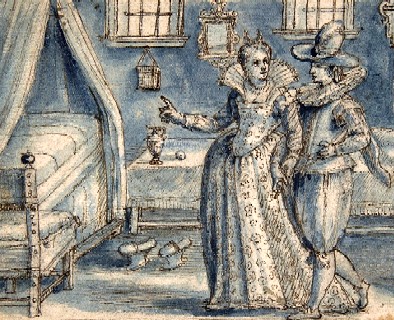
Artist: Crispijn de Passe the Elder
Woman Leading a Blindfolded Man to Bed (1599)
Fifteen Thousand that were register’d."6 Here his native host also tried to hire a woman for him, advising he and his companions that "we should have fine Women. I excused my self from accepting his Favours... Mr. Hudson [an English merchant from Tunis] assured me, that the Merchant was a Man of Honour, and I might trust him. I pretended my Affairs would not allow me to stay so long from the Ship"7.
Merchant and naval sailor Edward Barlow also mentions prostitutes several times in his Journal, which covered sixty-four years of sea travel. In 1661 his ship the HMS Augustine had stopped at Lisbon, Portugal. Barlow says he saw "many courtesans, many of them both young and handsome, who will call any Englishmen or strangers as they walk the streets, and will ask them in as good English as they can speak whether they will come in and drink the wine and take a bit to stay their longing"8. In 1669, the merchant ship he was on - the Reall Ffriendshipe - made landfall in Livorno, Italy where he again noted the presence of "many kind-hearted courtesans and brothel-houses, where many a man empties his pockets of moneys in keeping company with them"9. Barlow goes on to explain that it is the English who manage the brothels which are found throughout Spain, Portugal and parts of Italy; "suchlike houses of entertainment are in most places where any ships come, that trade never failing till it hath confounded both body and soul"10.
 Courtesians, India, Chronicle, 1870.jpg)
Nautch (Dancing Girls) Often Served as Courtesians in India,
From The Chronicle (1870)
Landing in Calcutta, India in 1670 aboard the East Indiaman Experiment, Barlow explained that a sailor "may have a black ‘hore’ for a small matter, for as you walk up and down they wil ask you weather you have any mind to it or no."11 Eighteen years later, while chief mate aboard the East Indiaman Rainbow, the ship stopped to careen near a city he called Casho (in modern Vietnam). Here, he recorded that the "women are very amiable and kind to strangers, and any Englishman or Dutchman may have some of the best in the land to keep as their new adopted wives for the value of twenty shillings the month"12.
Sexual iniquity wasn't limited to the English. Captain Alexander Hamilton noted that the Dutch had a town which he called 'Barnagul', north of Calicut, India which was "famously infamous for a Seminary of female Lewdness, where Numbers of Girls are trained up for the Destruction of unwary Youths, who study more how to gratify their brutal Passions, than how to shun the evil Consequences that attend their Folly, notwithstanding the daily Instances of Rottenness and Mortality that happen to those who most frequent these Schools of Debauchery."13 Merchant sailor Edward Coxere mentioned that while he was a prisoner aboard a Spanish vessel in the late 1650s, the ship was boarded by "two women reckoned to be whores coming to welcome such as might be for their turns."14
No one seems to have been more appalled by the oldest trade than the preachers (and future preachers). Around 1725, surgeon Silas Told noted that in Livorno, Italy "there are numerous gallies of war, supported by common prostitutes and strumpets tolerated by government, who have a considerable part of the city allowed them, wherein they commit all manner of abominations."15 (Told eventually became a Methodist chaplain at Newgate Prison, which may explain his distaste here.) John Ovington, Chaplain on the East India ship Benjamin, explained during the vessel's stop at Santiago in the Canary Islands that
the Women were very loose in their Behaviour, and easily led away by the Sailers, whose Immoral Extravagancies have occasion’d this Proverbial Speech in India, That in Sailing from hence thither, they leave their Consiences on this side of the Cape; and in returning from thence to Europe, they leave their Consciences on the other side the Cape. So that except it be in doubling the Cape, they will scarce allow an East-India-man any Conscience at all.16
Several buccaneer accounts mention prostitutes plying their trade with sailors. In Malaysia in 1705, buccaneer
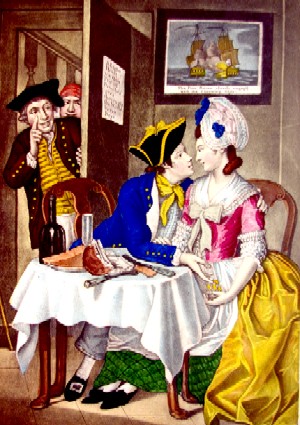
Artist: After John Collet
Sailor Paying a Woman for Sex, "Bachelors Fare", From
The British Museum (1777)
William Funnell found that the "Women here, are said to be great Whores; of which they are nothing ashamed. They are soon ripe, and often marry by nine Years of Age; and many of them are said to have Children by ten or eleven."17 Describing the Cape of Good Hope in 1686, fellow buccaneer William Ambrosia Cowley said that the women there "prostitute themselves or do what else you would have, for the least Recompense Imaginable; and of this I am an Eye-witness."18 (Interestingly, this is the closest any of the observers under study come to admitting to making use such services.)
While in Mindanao, Philippines, William Dampier commented that the sailors lived on shore, "some with Women-Servants, whom they hired of their [the women's] Masters for Concubines."19 He observed in Pulo Condore (modern Nam Ha, Laos) that the men there "are so free of their Women, that they would bring them aboard and offer them to us; and many of our Men hired them for a small Matter."20 Dampier went on to note that this was this was the case in a variety of other places including Tunquin (Tonkin, in what is now North Vietnam) where "most of our Men had Women aboard all the time of our abode there" and on the Guinea Coast of Africa where "Merchants, Factors, and Seamen that reside there, have their black Misses. It is accounted a piece of Policy ...and by this sort of Alliance the Country People are engaged to a greater Friendship"21.
Golden age pirate scribe Charles Johnson takes time in the chapter on Bartholomew Roberts to give an aside about the potential for intimate intrigues with the local women. He says that in Sierra Leone, the local traders keep
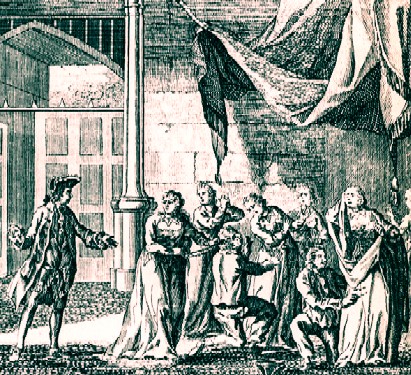
Woodes Rogers Collects the Jewelry of the Spanish Ladies in Guayaguil (18th c.)
"Women [who are] so obedient, that they are very ready to prostitute themselves to whomsoever their Masters shall command them."22 This closely corresponds to what Dampier had to say about the Guinea Coast.
Privateer Woodes Rogers does not discuss the trade in women specifically, but he does mention the results during his voyage around the world in the early 1700s. After they had taken Guayaquil, Ecuador in 1709, Rogers explained that "near half of our Spaniards discover’d publickly to our Doctors their Malady, in order to get Physick from them against the French Disease, which is so common here, that they reckon it not Scandal to be deep in the Powdering Tub [a sweating-tub used for treatment of syphilis]; and the Heat of the Country facilitating the Cure, they make wry light of it."23 Rogers also noted that "one John. Edwards, a Youth, who died of a Complication of Scurvy and the Pox [syphilis]"24.
None of these accounts mention the connection between harlots and venereal disease, although Rogers' account suggests it. Surgeons were not so shy, however. Sea surgeon James Yonge gives this rather vivid and detailed account in his Journal while his ship the Robert Bonaventure was in Genoa, Italy in 1664:
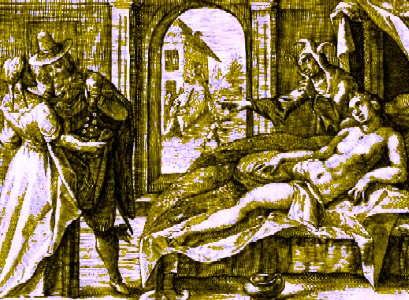
Artist: Crispijn de Passe the Elder - "Prostitution" (Late 16th/Early 17th c.)
Four of our men were clapt [contracted gonorrhea] and poxt [contracted syphilis] here the manner somewhat strange. Five of our men and two of Captain Mutum’s went to a whore; they bargained for two Ryals (that’s a shilling) to lie with her. One of ours, being a married man, went on first; the rest of ours afterward, and Captain Mutum’s last of all. The second of ours that went on had a gonorrhea in four days, two more of them in a week; the last escaped as did all Captain Mutum’s men. The first that went on through he had escaped too, till about a month after, just as we were going away, a bubo appeared in one groin. The reason I apprehend to be because those who went on first had imbibed and absumed the venereal matter in the vagina, and with their own sperm had, as it were, washed it clean, against the embraces of the other that escaped.25
Of course, if the woman in question was indeed infected, the other men would also have been exposed to the infection, although they either may not have displayed signs of it, or, perhaps, just not have been willing to admit it.
1 J. D. Davies, Pepys Navy, 2008, p. 166; 2 Francis Rogers. from Bruce S. Ingram's book Three Sea Journals of Stuart Times, 1936, p. 180; 3 Francis Rogers, p. 209; 4 Francis Rogers, p. 218; 5 Nathaniel Uring, A history of the voyages and travels of Capt. Nathaniel Uring, 1928, p. 97; 6 Uring, p. 191; 7 Uring, p. 200; 8 Edward Barlow, Barlow’s Journal of his Life at Sea in King’s Ships, East and West Indiamen & Other Merchantman From 1659 to 1703, p. 63; 9 Barlow, p. 163; 10 Barlow, p. 164; 11 Barlow, p. 193; 12 Barlow, p. 396; 13 Alexander Hamilton, British sea-captain Alexander Hamilton's A new account of the East Indies, 17th-18th century, 2002, p. 335; 14 Edward Coxere, Adventures by Sea of Edward Coxere, 1946, p. 69; 15 Silas Told, An Account of the Life, and Dealings of God with Silas Told &c., 1786, p. 53; 16 John Ovington, A Voyage to Suratt, 1696, p. 42; 17 William Funnell, A Voyage Round the World, 1969, p. 256; 18 William Ambrosia Cowley, "Cowley’s Voyage Round the Globe", A collection of original voyages, William Hacke, ed., 1993, p. 35; 19 William Dampier, A New Voyage Round the World, 1699, p. 365; 20,21 Dampier, p. 395; 22 Daniel Defoe (Captain Charles Johnson), A General History of the Pyrates, Manuel Schonhorn, ed., 1999, p. 226; 23 Woodes Rogers, A Cruising Voyage Round the World, 1712, p. 204; 24 Rogers, p. 253; 25 James Yonge, The Journal of James Yonge [1647-1721] Plymouth Surgeon, 1965, p. 72
Understanding VD in the GAoP: Pirates and Sex
"[Blackbeard] ...while his Sloop lay in Okerecock Inlet, and he ashore at a Plantation, where his Wife lived, with whom after he had lain all Night, it was his Custom to invite five or fix of his brutal Companions to come ashore, and he would force her to prostitute her self to them all, one after another, before his Face." (Daniel Defoe (Captain Charles Johnson), A General History of the Pyrates, Manuel Schonhorn, ed., 1999, p. 76)
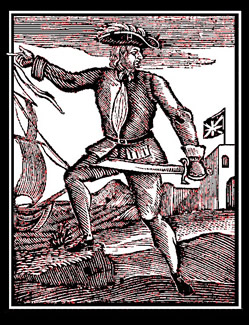
Pirate Howell Davis, From the General History
of the Pirates
(1728)
Pirates traded in the favors of women of the night just like their merchant counterparts. Johnson mentions that when Howell Davis stopped at São Nicolau in the Cape Verde Islands off the coast of Africa, they disguised his ship as an English merchant and he "remained five Weeks, in which Time, he and half his Crew... [were] caressed [er, meaning embraced] by the Governor and the Inhabitants, and no Diversion was wanting which the Portuguese could sew, or Money could purchase"1. After a week of that, "the rest of the Crew went to take their Pleasure up to the Town, in their Turn."2 The 'free Conversation of some Women' proved to be so enticing that five of Davis' pirates decided to remain on the island when the crew left five weeks later.
Bartholomew Roberts' men also made use of local prostitutes according to Johnson. While they were in port at Saint Barthélemy in the West Indies, "the Women ...endeavoured to out-vie each other in Dress, and Behavior, to attract the good Graces of such generous Lovers, that paid well for their Favors."3 In Sierra Leone, Africa, Roberts crew stayed six weeks until their "Ships being cleaned and fitted, and the Men weary of whoring and drinking, they bethought themselves of Business, and went to Sea"4.
Roberts men caputred the ship Samuel in August of 1720 off of Boston, the ship's captain noted that they "designed to sail to the Island of New-Providence, where he and his Companions will spend their Money with the Portuguese Negro Women."5 When describing Roberts' visit to Brazil, Johnson noted that the local women "are fond of Strangers, not only the Courtezans, whose Interest may be supposed to wind up their Affections, but also the marryed
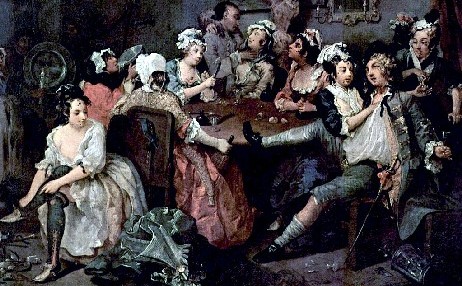
Artist: William Hogarth - Tom's Wild Night on the Town, A Rakes Progress (1732-5)
Women who think themselves obliged"6. However, he goes on to accuse most of the residents of being "touched with venereal Taints, without so much as one Surgeon among them, or any Body skilled in Physick, to cure or palliate the progressive Mischief", further warning his readers that "tho' few are exempted from the Misfortune of a Running [a symptom of gonorrhea], Eruptions [a symptom of gonorrhea, chancroid and syphilis], or the like, yet I could hear of none precipitated into those deplorable Circumstances we see common in unskillful mercurial Processes.7
Although most of the sailor's accounts refer to clandestine encounters involving prostitutes, several of the pirate's accounts contain more unsavory sexual escapades. As the quote about Blackbeard which leads this section attests, pirates were not above raping friends and family, let alone captured women. (Although it is worth noting that the story about his having a wife in Carolina
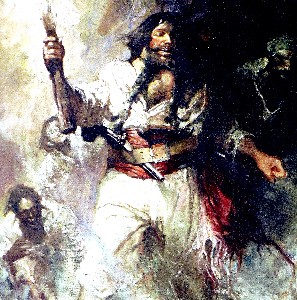
Artist: Frank Schoonover
Blackbeard (Edward Teach) in Smoke and Flames (1922)
may be one of several things that Johnson made up since he never met Edward Teach and there is no supporting documentation for it.) Since no crime could be punished more harshly than piracy, pirates seem to have had little compunction against committing other crimes.
With regard to Captain Teach, Johnson also explains that he "and his Companions often took [liberties] with the Wives and Daughters of the Planters [in Carolina], I cannot take upon me to say, whether he paid them ad Valorem [in proportion to what was taken], or no."8 (One cannot but wonder what, exactly, Johnson felt would be adequate compensation for such a thing.)
One of the more notorious episodes of rape occurred when Henry Every took the treasure-laden Indian vessel Ganj-I-Sawai as it was returning from Mecca in September of 1695. The crews capture of this well-fortified vessel and the substantial treasure haul were both notable, but it is the pirate crew's treatment of the women who were making the holy voyage which is of interest here. Several sources mention the men raping the female victims. Philip Middleton, a boy aboard Every's vessel Fancy, reported that "The men [pirates] lay with the India women aboard those ships [the Ganj-I-Sawai and her consort vessels] and there were
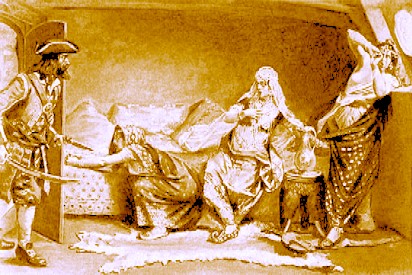
A VERY Fanciful (Meaning Highly Inaccurate) illustration of Henry Every
Taking
the Mogul's Granddaughter (1905)
several of them [Indian women, who] by their habits and riches in jewels appeared of better quality than the rest."9 Sailor Edward Barlow also noted in his Journal that Every "had taken one of the Mogul’s great ships ...and had ravished a great lady of the Court of the Great Mogul, who had been at Mocha to pay her devotions to their prophet Mahomet’s tomb, and was on board that ship in her return home"10. Barlow was not there, however, having probably heard this while in the service of the East India Company. A letter sent by the EIC to the Privy Council on October 12, 1695 reporting on Every's capture of the Indian vessels states that "there happened to be a great Umbraws Wife (as Wee hear) related to the King, returning from her Pilgrimage to Mecha, in her old age. She they abused very much, and forced severall other Women, which Caused one person of Quality, his Wife and Nurse, to kill themselves to prevent the Husbands seing them"11.
Captain Edward England's men had a penchant for rape as well. While in the Laccadive Islands off India, they attacked an island in the chain (probably Malandra) which caused the men to flee, leaving their women behind. Johnson says, "The Women they [the pirates] forced in a Barbarous Manner to their Lusts, and to requite them, destroyed their Cocoa Trees, and fired several of their Houses and Churches"12 Pirate captive Richard Lazenby also mentions this event (he likely being Johnson's source), explaining that the fleeing men left an "abundance of women and children hidden in the bushes, which the 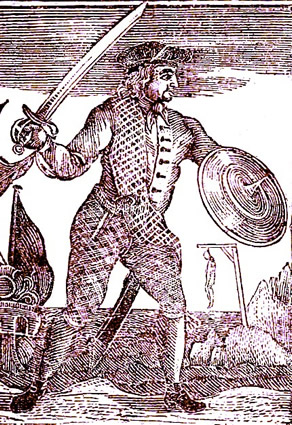
Pirate John Gow, General History of the Pirates (1725)
Pirates found and forced to their barbarous inclinations."13 Naval sailor Clement Downing similarly noted that while England's crew were on St. Mary's Island off Madagascar, they killed the local men "and abused their Women in a very vile manner. Some say, that Capt. England kept one or two of the Moors Women for his own Use, there being some of Distinction amongst them, whose Fathers were in high Posts under the Great Mogul."14
Some times rape turned even nastier (if that is possible.) An account from a newspaper reported on January 13, 1722, "That 21 of those Brutes had forc’d a Woman Passenger one after another and broke her Back, and flung her into the Sea."15 Although the culprits were not identified by the witnesses to this account, Charles Johnson suggests that it may have been Thomas Anstis' crew. (Although he also admits "I will not be positive it was Anstis's Crew that acted this unheard of Violence and Cruelty"16.)
Rape is also suggested in the accounts of Bartholomew Roberts. When his crew was wandering around the banks of Newfoundland in July of 1720, Roberts men captured Robert Peate's brigantine the Essex. Upon reaching Salem in August, Peate reported that Roberts' crew "did him considerable damage, and abused several Women that were Passengers on Board."17
Of course, such a prejudiced reputation could work against an honest pirate - if there could be such a thing. During his trial, pirate captain John Gow was accused by a former schoolmate of "Debauching some Young Women in the Orkneys [islands off of Scotland], and in taking them on Board his Ship, and exposing them as common to all his Men"18. Gow denied this, stating that his former comrade had 'misrepresented him' and "saying, that he was incapabale of such an undecent Villiany"19.
Before proceeding, it is worth noting that several pirate crews actually had
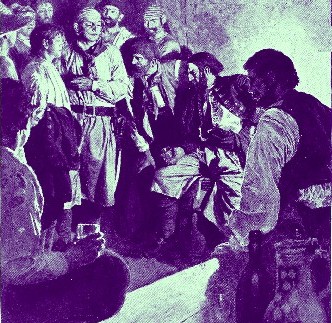
Artist: Howard Pyle - Pirates Meeting, Jack Ballister's Fortune (1894)
rules in their articles against bringing women aboard their ships. Bartholomew Robert's sixth article stated, "No boy or woman to be allowed amongst them. If any man were to be found seducing any of the latter sex, and carried her to sea, disguised, he was to suffer death"20. (This apparently had no effect on their behavior while aboard prize ships, as a previous account attests.) Pirate captain John (Richard) Taylor's articles were even more specific, advising that "Women taken in a prize are to be put ashore or given up to the hazards of the sea. No violence is to be offered to female prisoners on pain of severe punishment"21. (So, according to this article, it was reasonable to leave a woman on a sinking ship, but her rape was strictly taboo. Curiously, Taylor was first mate to Edward England, whose crew's sexual misconduct has already been detailed.)
Another such rule is mentioned by merchant captain William Snelgrave's in his account of his capture by Howell Davis' pirates. Davis' articles state that the pirates were "not to allow women to be on board their ships, when in the harbour. And if they should take a prize at sea, that has any women on board, no one dares, on pain of death, to force them against their inclinations."22 None of these rules had anything to do with the horror of the crime, nor with preventing the spread of venereal diseases. As Snelgrave's explains, Davis' article was simply "a good political rule to prevent disturbances amongst them, [so] it is strictly observed."23
1,2 Daniel Defoe (Captain Charles Johnson), A General History of the Pyrates, Manuel Schonhorn, ed., 1999, p. 169; 3 Defoe (Captain Charles Johnson), p. 218; 4 Defoe (Captain Charles Johnson), p. 228; 5 London Journal, 10-8-20 - 10-15, Issue LXIV; 6,7 Defoe (Captain Charles Johnson), p. 199; 8 Daniel Defoe (Captain Charles Johnson), A General History of the Pyrates, Manuel Schonhorn, ed., 1999, p. 77; 9 Philip Middleton, “Narrative of Philip Middleton, a youth belonging to the ship ‘Charles’ alias ‘Fancy’”, The Indian Antiquary, S. Charles Hill, ed., December 1919, p. 225; 10 Edward Barlow, Barlow’s Journal of his Life at Sea in King’s Ships, East and West Indiamen & Other Merchantman From 1659 to 1703, p. 472; 11 "60. Abstract, E.I. Co. Letters from Bombay. October 12, 1695", Privateering and Piracy in the Colonial Period - Illustrative Documents, John Franklin Jameson, ed., 1923, p. 147; 12 Defoe (Captain Charles Johnson), p. 126; 13 Richard Lazenby, “Letter from Richard Lazenby”, The Indian Antiquary, S. Charles Hill, ed., Volume XLIX, March, 1920, p. 42; 14 Clement Downing, A Compendious History of the Indian Wars, 1737, p. 111-2; 15 Weekly Journal or British Gazetteer, 1-13-22; 16 Defoe (Captain Charles Johnson), p. 289; 17 London Journal, 10-8-20 - 10-15, Issue LXIV; 18 “A True and Genuine Account of the Last Confession and Dying Words of John Gow, alias Smith, Captain of the Pirates”, 1725, p. 12; 19 Daniel Defoe (Captain Charles Johnson), A General History of the Pyrates, Manuel Schonhorn, ed., 1999, p. 76; 20 Ed Fox, citing Jacob du Bucquoy, Piratical Schemes and Contracts, Doctoral Thesis, p. 315; 21 Captain William Snelgrave, A New Account of Some Parts of Guinea and the Slave Trade, 1734, p. 256; 22,23 Snelgrave, p. 256-7

